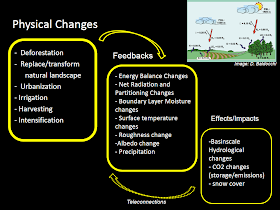More on the implications of this report from WattsupWithThat and NextBigFuture.
It is likely that black soot and black carbon are far more responsible for melting glaciers and polar ice than is CO2 -- although the largest cause of melting polar ice and glaciers is natural variation in chaotic climate cycles and natural variation of winds and ocean currents.
But if polar bears needed to blame one particular thing for being forced to swim longer distances in a bad year, they should probably blame black soot from China and India.
Other significant anthropogenic influences of climate besides black soot include land use changes, shown in the image above. Over the long run, both land use changes and black soot emissions are likely to have far greater effects on glacial and polar ice than CO2. Why?
For one thing, we can do more about black carbon emissions than we can about CO2 emissions. For another, there are several powerful negative feedback apparati in nature that compensate for anthropogenic CO2 production. That is not nearly the case for black soot production. For yet another, the very wide range of estimated CO2 sensitivity on climate forcing as much as tells you that scientists have not got a precise handle on the actual importance of CO2 on climate.
As you can see from the graphic above, global temperatures have been stuck on a plateau -- at the same time that atmospheric CO2 levels (and climate model temperature predictions) have been rising. The perceived disconnect between atmospheric CO2 and global temperatures may be exaggerated by natural climate cycles, of course.
But if you add the combined anthropogenic climatic effects of CO2, black soot, and land use changes together, you have to wonder what kind of natural cycles would be necessary to bring "global warming" to such a screeching halt?
More on the AGU study:
The study, a four-year, 232-page effort, led by the International Global Atmospheric Chemistry (IGAC) Project, is likely to guide research efforts, climate modeling, and policy for years to come, the authors and other scientists familiar with the paper said.
The report’s best estimate of direct climate influence by black carbon is about a factor of two higher than most previous work. This includes the estimates in the 2007 Intergovernmental Panel on Climate Change (IPCC) Assessment, which were based on the best available evidence and analysis at that time.
Scientists have spent the years since the last IPCC assessment improving estimates, but the new assessment notes that emissions in some regions are probably higher than estimated. This is consistent with other research that also hinted at significant under-estimates in some regions’ black carbon emissions.
The results indicate that there may be a greater potential to curb warming by reducing black carbon emissions than previously thought. _GCC
Climatology is still just a baby science -- not ready for prime time. And yet the IPCC wants to control the redistribution of $trillions worth of resources from the developed world to the emerging and third worlds. Purely as a humanitarian gesture, no doubt. After all, who would want the hassle of channeling all of those trillions of dollars, if they did not have the best interests of humanity at heart?
A sober reminder about the chaotic underlying nature of climate:
A paper titled "Global Warming: A Geological Perspective," published in Environmental Geosciences, and summarized below in Arizona Geology, should be required reading for all climate scientists. The paper notes that if
"the temperature increase during the past 130 years reflects recovery from the Little Ice Age, it is not unreasonable to expect the temperature to rise another 2 to 2.5 degrees Celsius to a level comparable to that of the Medieval Warm Period about 800 years ago"and that
"Climatic changes measured during the last 100 years are not unique or even unusual when compared with the frequency, rate, and magnitude of changes that have taken place since the beginning of the Holocene Epoch. Recent fluctuations in temperature, both upward and downward, are well within the limits observed in nature prior to human influence."Sadly, most climate scientists fail to study or understand the geologic history of climate, which has led to countless false claims that today's climate is unnatural, extreme, unusual, or unprecedented. __ Source __ via __ GWPF
Summary paper PDF with more
Note that the paper referred to above was published in 1999 in Environment Geosciences, at the peak of confidence in catastrophic global warming. If the words were true then, they are triply true now that temperature trends have flattened, and multiple causes of warming unrelated to CO2 have been described and verified.
Popular climate alarmism and CO2 hysteria resemble the mood manipulation one sees in Hollywood blockbusters, where the soundtrack works together with scripting, acting, and clever camera angles to ratchet up audience panic to a fever pitch.
Such mood manipulation on a society-wide scale requires large numbers of useful idiots, gullible clowns, and power control freaks inside government, academia, and media. No surprise here, that is simply how things are managed in a settled regime -- between revolutions.



I am agnostic on Global Warming, but it is curious that we just got out of Ice Age and people are worried about it getting too hot....and Ice Ages have been the norm for the last several hundred thousand years.
ReplyDeleteThe reasons I am agnostic on Global Warming is
1. You have pretty good experts on both sides of the issue.
2. The price signal does not work when it comes to pollution. It may be some regulation is needed, if pollution is causing global warming of a dangerous nature.